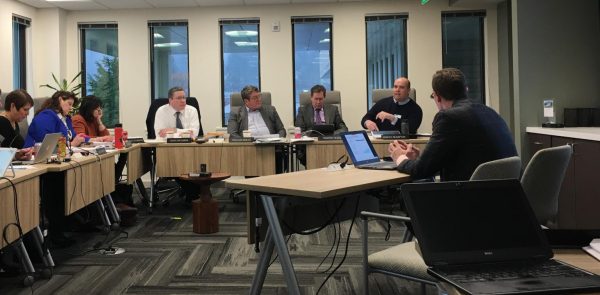
Alaska lawmakers and the trustees that govern the Alaska Permanent Fund have different ideas about how to protect the fund’s future. The difference is based in politics — and math.
The Alaska Permanent Fund has two parts. The larger part, which currently has $49 billion in it, is protected under the state constitution.
The second part holds the money that the $49 billion earns. It’s called the earnings reserve account, or ERA. It has roughly $18 billion, and it’s not protected. Alaskans get their permanent fund dividends from there, and it now pays for much of state government. And a majority of both legislative chambers could vote to spend every dollar in it.
And that presents a political dilemma, at a time when Gov. Mike Dunleavy and some legislators want to pay back the amounts PFDs have been cut the past four years.
When Senate President Cathy Giessel, an Anchorage Republican, visited the Alaska Permanent Fund Corp. board meeting last week, she delivered a message about the ERA.
“We’re very concerned that that ERA is simply too vulnerable, having that $18 billion there that some folks believe is money to spend, is hugely concerning,” she said.
That’s why the Legislature voted last year to move $10.5 billion from the ERA into the protected principal. Dunleavy vetoed most of that, saying it would reduce the state’s ability to respond to future revenue shortfalls and may reduce the state’s ability to pay permanent fund dividends under the 1982 law that he’s committed to following.
Giessel said lawmakers want to transfer more money this year.
“The Senate, at least, will be attempting to move yet more into that protected part of the fund, because we’re just so afraid that that’s going to be spent,” she said.
But while Giessel is focused on the possibility that lawmakers will spend the ERA down to nothing, the permanent fund corporation’s board of trustees are concerned about another way the reserve could hit zero: the market.
While the ERA technically has $17.9 billion in it, $7.7 billion is already committed to be taken from the fund before July. That includes $3 billion the state is counting as part of its annual draw from the ERA to pay for state services and the dividend.
So, if the value of the fund’s investments fell deeply in a market crash, it wouldn’t be that long of a drop to reach zero. One study found that there was a 50% chance the fund would hit zero at least once over a 20-year period.
If the ERA hit zero, the fund could sell some assets to generate cash, but that would present its own problems, since the fund is supposed to aim for long-term goals, not respond to short-term crises.
So the board wants to keep more money in the ERA, rather than in the protected principal.
Trustee Corri Feige, the state’s commissioner of the Department of Natural Resources, said the state must be careful about the ERA.
“It serves a dual purpose of both helping to protect the operation of the overall fund, and, should there be a 2008, 2009 style of event, it would allow the fund that flexibility and agility that it needs to survive without taking out a significant amount of the principal, so there’s lots of factors to be balanced,” she said.
The more money that’s in the ERA, the healthier it is. But when there’s more in the protected principal, the ERA can actually be more exposed to a drop in the market.
Greg Allen is the CEO of Callan, a consultant for the corporation. He said the ERA would actually be more durable if the state just spent money from it.
“I can’t make this stuff up, right?” he told trustees. “I stared at it forever and I’m like, ‘This can’t be right. This doesn’t make any sense.’”
But Allen doubled-checked the math, and it held up.
Trustee Marty Rutherford said it’s important for the trustees to tell the Legislature about their concern about the ERA.
“I worry that people are going to start to ‘fix’ our problems without knowing exactly what and how to fix them,” she said.
Trustees said one way to protect the fund would be to require that the ERA have at least four times as much money as the state expects to draw from it each year. The board discussed urging the Legislature to adopt this as a rule, or using another method to ensure there are enough funds in the ERA in the future.
Their position may be met with skepticism from at least some legislators.
Sitka Republican Sen. Bert Stedman said he’s more concerned about the possibility that the Legislature could start spending from the ERA in the short term to pay out larger dividends than he is about the effect of a drop in the value of assets over the long run.
“Spending a lot of time with probability analysis on a 20-year risk exposure is a good exercise,” Stedman said. “Politically, it’s foolish. We need to deal with the next two to three years, and fix our fiscal position.”
The trustees plan to meet again in the next few weeks.
Andrew Kitchenman is the state government and politics reporter for Alaska Public Media and KTOO in Juneau. Reach him at akitchenman@alaskapublic.org.




